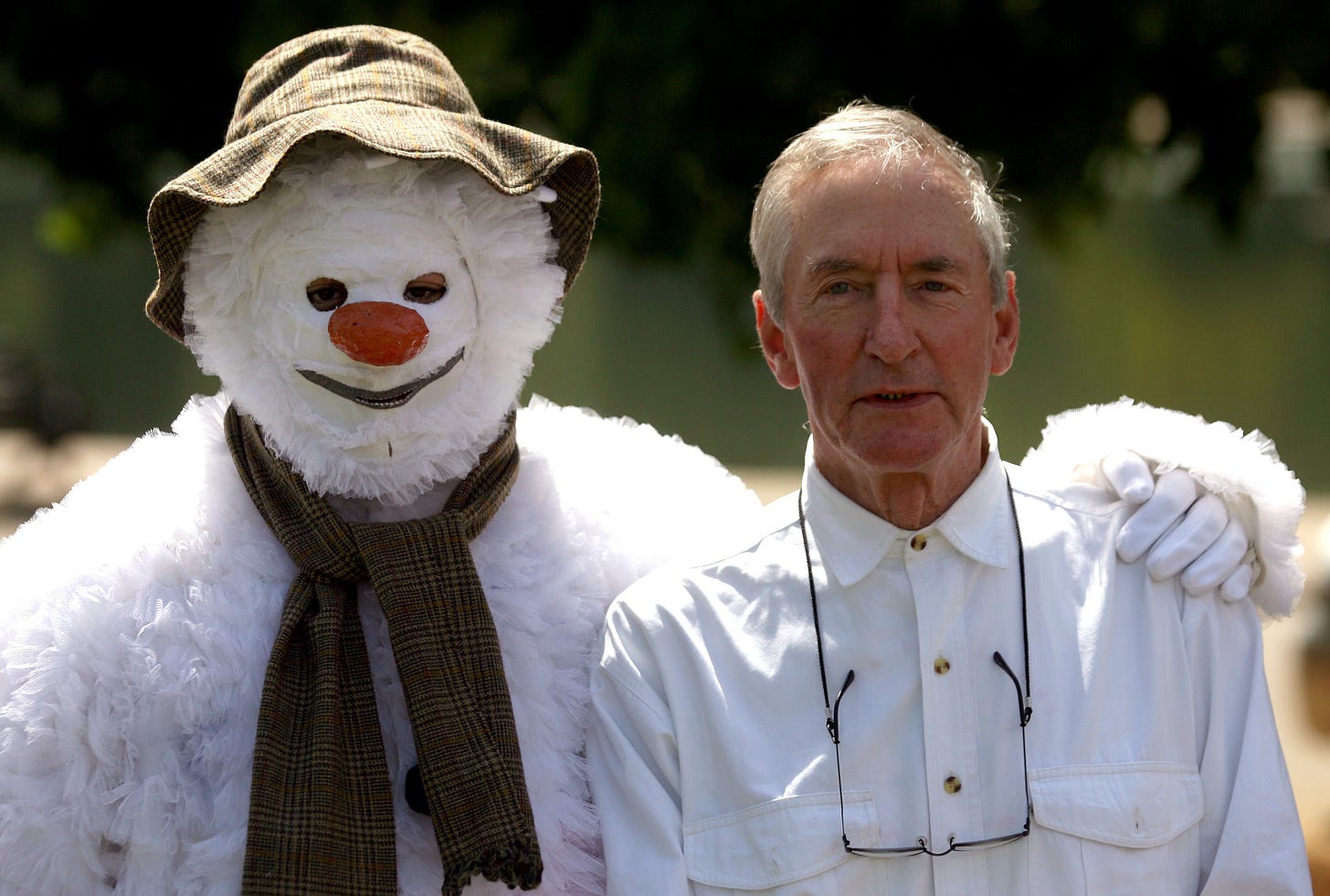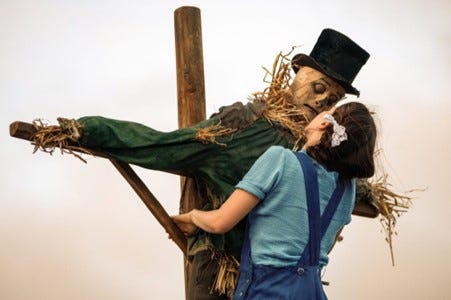[Spoilers: The Snowman, (1982), The Witch (2015), Pearl (2022)]
‘Horror Moments’ is a weekly series examining horror-inflected scenes and themes in unexpected places. The ‘moments’ are published weekly on Thursdays, and I share articles on the history of magic, theatre, storytelling, and more on Monday afternoons – don’t forget to subscribe! Catch up with the Kate Bush series here and the full back catalogue of horror moments (from Wallace & Gromit to Shakespeare) here.
In our penultimate Kate Bush horror moment, I wanted to turn to her most recent album, 50 Words for Snow, which was released in 2011. Many of these tracks are long and roomy, their stories take their time: the shortest is 6:49 and the longest, ‘Misty’, is 13:32.
‘Misty’ is also the most erotic track, which is bizarre because it’s a story about a woman building a snowman. What might have been a jolly Christmas premise turns to folk horror when the snowman comes to life and slips into her bedroom in the dead of night in search of her warming flesh. It’s a song in which a woman has sex with a snowman, yes, but it’s also a deeply creepy lament for a lost otherworldly love.
Roll his body
And give him eyes
Make him smile for me
And give him life
My hand is bleeding
I run back inside
Like many a supernatural entity before him, the figure our narrator sculpts from snow is imbued with life by the splash of human blood when she injures her hand. That night as she lies in bed asleep a nightmarish yet strangely thrilling vision arrives:
I turn off the light
Switch on a starry night
My window flies openMy bedroom fills with falling snow
Should be a dream but I'm not sleepy
I see his snowy white face
But I'm not afraid
He lies down beside me
When British people think of a snowman coming to life, we typically imagine the tender and superbly animated film The Snowman (1982) based on a picture book by Raymond Briggs published in 1978.
Here, a little boy builds a snowy friend and flies away with him on a wintry adventure. Briggs’ snowman is a kind and gentle figure with an appealing face, but the story is far more melancholy than we might expect from a Christmas classic. As a matter of fact, festive elements like the appearance of Father Christmas were added when the story was brought to life in animation. Briggs’ original focus was never on seasonal merriment but on what it means to lose someone we love. He said that the story was meant to confront the ‘natural and inevitable’ fact of death, and many a child was forever scarred by the horror of that final scene where the boy rushes out to meet his friend again and finds him gone, the last shot is him mournfully clutching the discarded scarf. Briggs doesn’t shy away from the mundane tragedy of the snowman melting away from the boy forever.
Incidentally, Briggs is also responsible for the graphic novel When the Wind Blows (1982) which was adapted for film in 1986, and is often considered a companion piece to Threads, which we explored last week. Here, we follow an elderly retired couple as they struggle to survive after a nuclear attack on Britain. A sensibility for horror is thus no stranger to the author of The Snowman — and the costumes made for its stage adaptation frankly belong on Summerisle.
If there is latent gloom throughout The Snowman, Bush’s misty figure is far more frightening from the offset. This is not quite a Pygmalion story, where an ideal lover springs from sculpted stone, it’s more like Frankenstein where the presence of life suddenly reveals the uncanny wrongness of the creation. The narrator has made something which now seems grotesque, more like a golem or a creature conjured from the earth than an ideal man:
He won't speak to me
His crooked mouth is full of dead leaves
Full of dead leaves
Bits of twisted branches and frozen garden
Crushed and stolen grasses from slumbering lawn
He is dissolving
Dissolving before me and dawn will come soon
Like Briggs’ story, the song ends with the snowman melting. Here, this dissolution is distinctly sexual, a petite mort that marks the culmination of an encounter so steamy he cannot survive it:
I can feel him melting in my hand…
Sunday morning I can't find him.
The sheets are soaking.
In ‘Misty’ this absence isn’t just sad, it’s sexually frustrating. Whatever exactly took place during the night, the implication is that our narrator will never again experience an encounter as exciting.
At one point she asks ‘what kind of spirit is this?’ and the question is never resolved. It reminds me of old legends of demon lovers and of fairy suitors who all sound like forbidden fantasies, manifestations of suppressed desire, often relating to female protagonists. Think of the role of ‘Black Phillip’ in Robert Eggers’ The Witch (2015) who tempts the young protagonist to abandon her Puritan farmstead and ‘live deliciously’ with him.
The campy weirdness of the song also makes me think of a scene from Pearl (2022) where an isolated and increasingly unhinged Texas farmgirl uses a scarecrow as a prop in her sexual fantasy. He looks unnervingly corpse-like (and Christ-like). He too is fashioned from natural materials, a product of the season, this time built from the debris of summer rather than of winter. In the isolation of his landscape, he seems capable of unleashing a secret desire. Are these lovers safer than real men, or do they pose a far more complex otherworldly temptation?
And if you’re wondering whether Bush is imagining a sort of hunky man made out of snow or an actually blob-shaped, carrot-nosed snowman, well just look at the album cover. Or watch the strange ‘Mistraldespair,’ an animation released to accompany a segment from the song:
Next week, we reach our final Kate Bush horror moment and say goodbye to a series I have hugely enjoyed researching and writing. Which song do you think I’ll choose last? And what’s your favourite story about a supernatural lover?
Be careful who and what you welcome into your bed from the cold and until next time, happy nightmares everyone!
Horror moments are posted every Thursday and a wide variety of articles exploring the history of magic, theatre, storytelling, and more are published on Mondays.






Okay. That got weird really quickly. Brilliant :)
Thank you for another enjoyable spin with Kate! You've reminded me of how well the lyrics balance the sense of dream and the sensuousness, especially in those last lines. And I like your inclusion of the Raymond Briggs story, which looks to all the world like a nice children's yarn for Christmas but actually has a poignant note.
Now, which one shall you do last? I have ideas! Several! The Dreaming has several songs with hints of Other. So I'll close my eyes and pick one... All The Love. Voices across different lives.
I wait to see which song you pick!